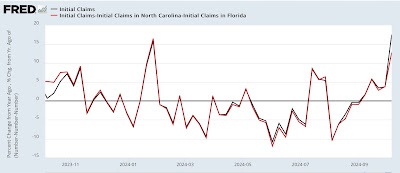- by New Deal democrat
As I indicated yesterday, today’s initial jobless claims report was particularly challenging, due to hurricane effects and unusual seasonal adjustments. The Columbus Day holiday may also have affected the numbers.
To cut to the chase, even after accounting for distortions, the number was very elevated YoY, which if it continues will be a real cause for concern.
First, let’s do the typical roundup. Nationally, initial claims declined -19.000 to 241,000. The four week average increased 4,750 to 236,250. With the typical one week lag, continuing claims rose 9,000 to 1.867 million:
On the YoY% basis more important for forecasting, without any special adjustments initial claims were higher by 19.3%, the four week average by 12.2%, and continuing cliams by 3.3:
If there were no special factors, the big YoY jump in initial claims would warrant a yellow caution flag.
The elevated claims numbers for the first two weeks of October preliminarily forecast a jump in the unemployment rate in the next monthly jobs report as well (here shown at the YoY% changes in each):
Now let’s look at the hurricane and other adjustments compared to last week (the graphs won’t be up at FRED until tomorrow, so I’ll just list the numbers).
On a nationwide basis, non-seasonally adjusted initial claims, at 224,763, were 42,369 higher than one year ago, or by 23.2%.
Last week Michigan and Ohio showed a big spike in initial claims. Per the DoL, this appears to have been motor vehicle production related layoffs. This week Michigan’s numbers declined -7,812 and Ohio’s -2,532. Still compared with one year ago, the two State’s numbers were higher by 2,237. In other words, most but not all of the spike has disappeared this week.
Surprisingly, Florida also showed a big decline this week, down -3,428. On a YoY basis, Florida’s claims were only 107 higher than last year. Either Milton won’t show up until next week, or the damage may have been so severe that people couldn’t file their initial claims yet. Either way, a huge jump is almost certainly going to happen within the next week or two.
North Carolina, by contrast, continued to have very elevated claims YoY, up 5,603 vs. last year.
Which means, combined, the two hurricane affected States contributed only 5,710 to the 42,369 nationwide increase. Thus the YoY% increase excluding those two States remains 21.2% - a very big jump (note that graph below does not include this week’s State numbers (red) for NC and FL):
But that brings us to the last issue, which is the effects of the national holiday. Remember that last week there was a 5% disparity in the YoY comparisons in favor of the non-seasonally adjusted measure. This week that reversed, with a 4% disparity in favor of the seasonally adjusted measure. Here’s what the YoY comparisons look like for both:
Last year’s 202,000 seasonally adjusted claims number was one of the lowest of the entire year, meaning that the YoY comparison this week was especially difficult. Against either the week before or after this week last year, YoY claims would only be higher by about 7%.
The bottom line is that the hurricanes are continuing to have a significant effect on jobless claims, but that even accounting for those, on a YoY basis claims remain quite elevated. But because of the holiday distortions, we will have to wait at least one more week to see if this is really the beginning of a concerning trend.


























